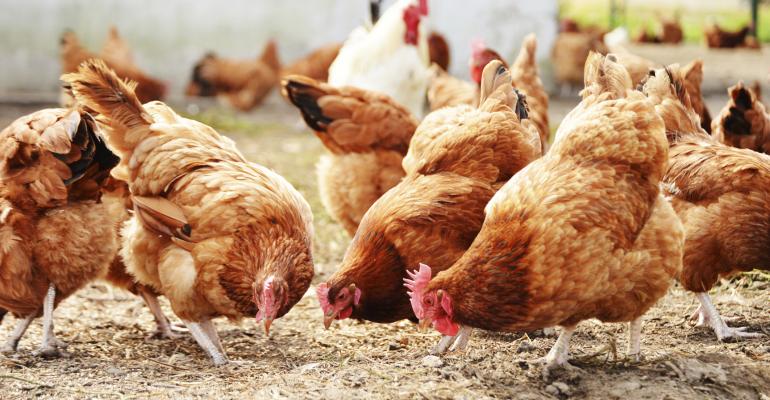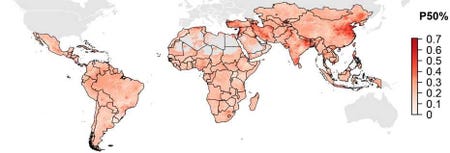Low- and middle-income countries have limited surveillance capacities to track antimicrobial use and resistance on farms
September 20, 2019

The world is experiencing unprecedented economic growth in low- and middle-income countries, so as an increasing number of people in India, China, Latin America and Africa have become wealthier, consumption of meat and dairy products has increased.
Researchers with the Swiss Federal Institute of Technology in Zurich (ETH Zurich) in Switzerland noted that meat consumption has risen by more than half in Africa and is up by two-thirds in Asia and Latin America.
To meet this growing demand, animal husbandry has been intensified, with, among other things, an increased reliance on the use of antimicrobials for treatment and prevention of animal disease but also -- where not regulated -- to increase weight gain and profitability, ETH Zurich said in an announcement describing a recent research project that mapped antimicrobial resistance (AMR) in low- and middle-income countries.
According to ETH Zurich, low- and middle-income countries have limited surveillance capacities to track antimicrobial use and resistance on farms. Antimicrobial use is typically regulated and documented less there than in wealthy industrialized countries with established surveillance systems, the institute said.
A team of researchers led by Thomas Van Boeckel, SNF assistant professor of health geography and policy at ETH Zurich, recently published the study in the journal Science.
The team assembled a large literature database and found out where and in which animals species resistance occurred for the common foodborne bacteria salmonella, Escherichia coli, campylobacter and staphylococcus.
According to this study, the regions associated with high rates of antimicrobial resistance in animals are northeast China, northeast India, southern Brazil, Iran and Turkey. In these countries, the studied bacteria are now resistant to a large number of drugs that are used not only in animals but also in human medicine. An important finding of the study is that, so far, few resistance hotspots have emerged in Africa with the exception of Nigeria and the surroundings of Johannesburg, South Africa.

ETH Zurich said the highest resistance rates were associated with the antimicrobials most frequently used in animals: tetracyclines, sulphonamides, penicillins and quinolones. In certain regions, these compounds have almost completely lost their efficacy to treat infections.
New index
According to the announcement, the researchers introduced a new index to track the evolution of resistance to multiple drugs -- the proportion of drugs tested in each region with resistance rates higher than 50%. Globally, this index has almost tripled for chicken and pigs over the last 20 years. Currently, one-third of drugs fail 50% of the time in chickens, and one-quarter of drugs fail in 50% of the time in pigs, ETH Zurich said.
"This alarming trend shows that the drugs used in animal farming are rapidly losing their efficacy," Van Boeckel explained, noting that this will affect the sustainability of the animal industry and potentially the health of consumers.
The researchers said it is of particular concern that AMR is rising in developing and emerging countries because this is where meat consumption is growing the fastest, yet access to veterinary antimicrobials remains largely unregulated.
"Antimicrobial resistance is a global problem. There is little point in making considerable efforts to reduce it on one side of the world if it is increasing dramatically on the other side," Van Boeckel added.
For their current study, the team of researchers from ETH, Princeton University and the Free University of Brussels in Belgium gathered thousands of publications as well as unpublished veterinary reports from around the world. The researchers used this database to produce the AMR maps.
However, the maps do not cover the entire research area; there are large gaps in South America, in particular, which researchers attribute to a lack of publicly available data.
"There are hardly any official figures or data from large parts of South America," said co-author and ETH postdoctoral fellow Joao Pires. He said this surprised him, as much more data is available from some African countries, despite resources for conducting surveys being more limited than in South America.
Open-access web platform
The team has created an open-access web platform resistancebank.org to share their findings and gather additional data on resistance in animals. For example, veterinarians and state-authorities can upload data on resistance in their region to the platform and share it with other people who are interested.
Van Boeckel said he hopes that scientists from countries with more limited resources for whom publishing cost in academic journal can be a barrier will be able to share their findings and get recognition for their work on the platform.
"In this way, we can ensure that the data is not just stuffed away in a drawer, because there are many relevant findings lying dormant, especially in Africa or India, that would complete the global picture of resistance that we try to draw in this first assessment," he said. "The platform could also help donors to identify the regions most affected by resistance in order to be able to finance specific interventions."
As meat production continues to rise, the web platform could help target interventions against AMR and assist a transition to more sustainable farming practices in low- and middle-income countries. "The rich countries of the Global North, where antimicrobials have been used since the 1950s, should help make the transition a success," Van Boeckel said.
Source: ETH Zurich, which is solely responsible for the information provided and is wholly owned by the source. Informa Business Media and all its subsidiaries are not responsible for any of the content contained in this information asset.
You May Also Like

.png?width=300&auto=webp&quality=80&disable=upscale)

